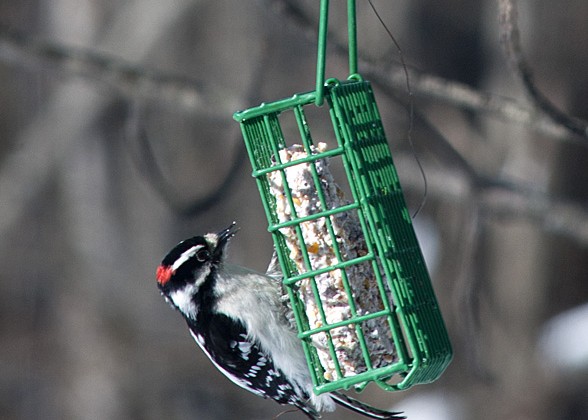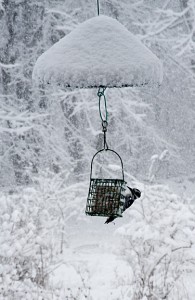Winter Birds
By Lindsey Pizzica Rotolo
Most of us, at one point or another, question why we stay in the Icebox of Connecticut throughout the winter months, but do you ever wonder why the birds do? When observing a little black-capped chickadee chipping away at a backyard feeder with four inches of snow on it, do you ever get the urge to call out, “You know you can actually feel the warmth of the sun just an hour and a half south of here, right?!”
But, it turns out, they don’t really care. Birds are heartier than they look. And, like so many of us, they would rather stick around their home year-round, despite the weather, because it’s a lot more work and aggravation to abandon ship for eight months and then return and rebuild.
So how exactly do these tiny animals survive the frigid temperatures and snow accumulation? For starters, they’re warm-blooded, like us, and maintain a constant body temperature of around 106 degrees. They also put on fat in late fall for protection and extra energy. Larger birds grow an extra set of feathers as winter settles in.
Some types of birds, like sparrows, seek shelter in whatever little cozy hideouts they can find with as many friends as possible. They huddle together and tuck their heads and feet into their bodies when the temperatures plummet.
One of the smallest winter birds, the chickadee, shivers to get through the winter. This process reinvigorates the blood flow throughout their bodies.
Another survival tool of many types of birds is the ability to focus warm blood around their vital organs while allowing extremities to cool down. Birds also practice something called regulated hypothermia, where they are able to bring their body temperature down by as much as 25 degrees, therefore conserving energy and fat stores.
Their behavior changes in winter, too, contributing to their survival. Birds that are overtly territorial in warmer weather, like the cardinal and blue jay, tend to lighten up in the cold months and flock peacefully together with dozens of other birds.
Birds’ single most important criteria for where they call home is ample food supply, so they won’t leave even the Icebox of Connecticut if there’s abundant food. Not to worry if your feeder goes empty for a week or two, that isn’t the only way they survive the winter. The average bird travels to between seven and nine different food sources every single day, and it’s rare for them to focus solely on feeders.
That’s not to say they don’t appreciate our hand-outs. While cold temps aren’t enough to send a lot of birds packing, snow cover definitely is. Most birders are in agreement that the best combination of foods to attract the widest range of birds at your winter feeders is to combine peanuts, cracked corn, black oil sunflower seeds and safflower seeds. If squirrels become the most frequent guest at your feeders, switch to just safflower seeds. They seem to have no taste for the stuff.
It may come as a surprise how many types of birds tough out the winter here. Aton Forest conducts an annual winter bird count on their 1,200 acre property in North Norfolk. This year’s count took place on a particularly snowy January day and they still observed 13 different types of birds: a great horned owl, downy woodpecker, blue jay, American crow, black-capped chickadee, tufted titmouse, red-breasted nuthatch, white-breasted nuthatch, eastern bluebird, American robin, dark-eyed junco, purple finch and American goldfinch.
Reports from some of Norfolk’s most adept birders say that there hasn’t been anything too out of the ordinary this winter. Mary Ann McGourty reports that the usual suspects have been frequenting the feeders (chickadees, nuthatches, juncos, titmice, finches, woodpeckers and a few sparrows).
Susannah Wood reports frequent bluebird sightings this winter, which isn’t that common (bluebirds are typically only seen year-round along the Connecticut shoreline). The bluebirds’ larger cousin, the American robin has also untypically stuck around the northern part of the state this winter. But this isn’t earth shattering news. Since we have typically had less frequent snow cover over the past ten to 15 years, birds that used to travel south are staying here 12-months of the year. For example, as recently as 1990, it was rare to see cardinals in Norfolk during the winter, but now this is commonplace.
One exciting new development on the birding front is the abundance of bald eagles in Litchfield County this year. Another bird of prey, the red tailed hawk, has also been much more frequently sighted in this neck of the woods.
Last winter, after seeing several pine grosbeaks in town (a rare event), McGourty started a bird alert system. “Instead of sending multiple emails or making a bunch of phone calls to all the people I knew would be interested in rare bird activity, I decided to set up an email alert.” If you are interested in being added to her list, email her at hillsidegardens@yahoo.com. In the meantime, embrace the season— just like the birds do.


